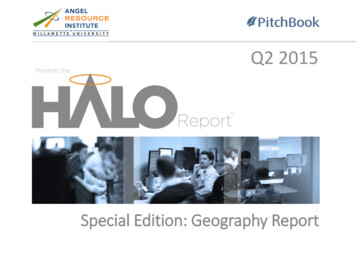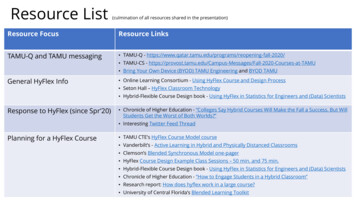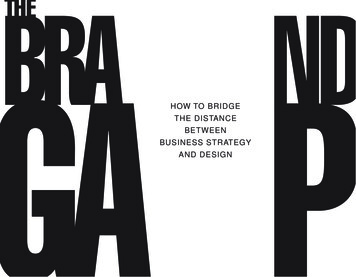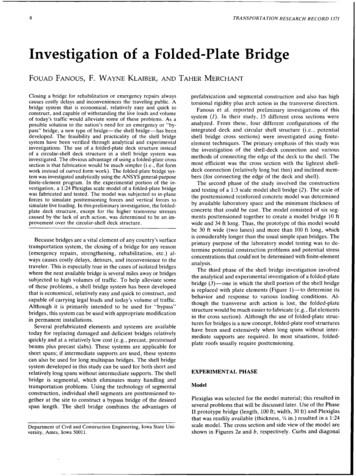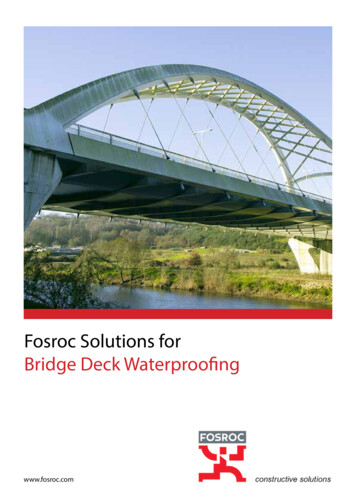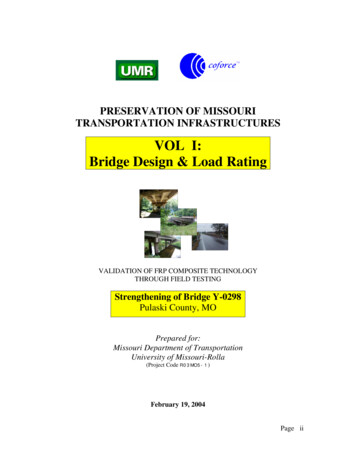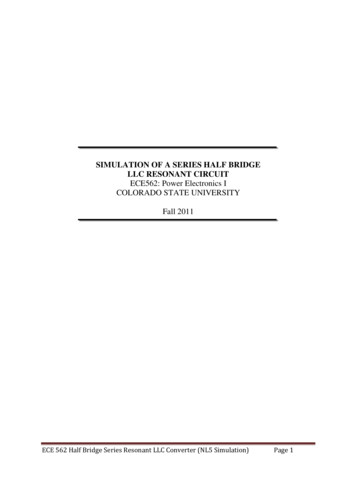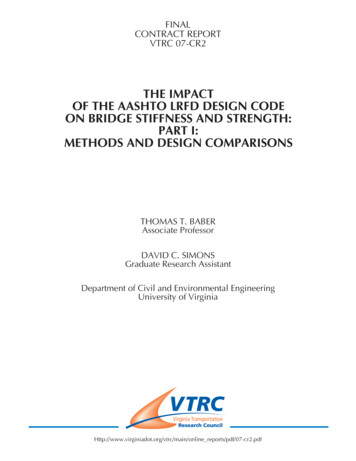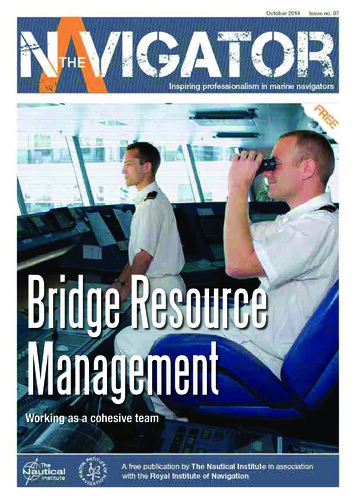
Transcription
Bridge ResourceManagementWorking as a cohesive team
Managing expectationsWe are all human, and we all makemistakes. These mistakes can lead tomajor catastrophes. Or, if caught in time,they could lead to nothing more than alesson learned.Many navigators stand bridge watchesalone or as the sole watch-keeper. In thesetimes, they alone are responsible for alldecisions pertaining to safe navigation andcollision avoidance, and the world expectsperfect performance: no mistakes, ever.We should also recognise that shippingis one of the safest methods of transportaround, and that it is likely that mostnavigators will have long careers at seawithout major incidents. This will be theresult of competence, preparation andgood teamwork.In the early 1990s, the maritimeindustry adopted a formal approachto teamwork, derived from the aviationindustry and defined by the IMO as BridgeResource Management (BRM). BRM is theeffective management and utilisation of allresources, human and technical, availableto the bridge team, to ensure the safecompletion of the vessel’s voyage.In essence, BRM is the process andpractice of using all available informationand assistance to ensure that navigatorsmake the best possible decisions, andthat those inevitable human mistakesare captured and mitigated before theycan cause any harm. There are manyresources to assist the navigator. Froman information perspective, these includecharts, publications, the passage planand electronic aids like radar, radio, GPSetc. From a human point of view, there arelook-outs, additional officers, the Masterand often a pilot, VTS and even onboardengineers. This is why all Masters’ standingorders require the Master to be called atthe earliest indication of a problem, toInside this issue0308091011strengthen the team.To get the best out of these resources,it is essential to train regularly, practiseusing them together and always reflect onhow improvements can be made, whetherthings go right or wrong. Good BRM is aculture that needs to be embraced, bothat sea and ashore. The IMO requires BRMto be taught, usually as a shore-basedcourse. Then, companies ensure that it isimplemented and continually improved atsea. Good BRM must be a core conceptfor all ranks at sea and ideally evaluatedthrough regular navigation audits.In this issue, we explore BRM and focuson best practices of teaching it (ashore) andimplementing it (at sea). Good teamworkdoesn’t stop on the bridge, but alsoextends to professional bodies, such asThe Nautical Institute, where professionalsof all ranks work together to fosterContinuing Professional Development.So please help us to share this magazineamongst all navigators. It’s free, andavailable from www.nautinst.org/navigator.A Nautical Instituteproject sponsored byALL@SEABRIDGING THE GAPIN TRAININGMembers of The Nautical Institute’s LinkedIn communityoffer their views on Bridge Resource ManagementA look at the advantages, challengesand content of shore-based BridgeResourceManagementtrainingWATCH OUT04-05Accident report: How inadequate use of bridgeresources led to a tanker grounding one mile off courseWHO’S NAVIGATING?Three officers from livestock carrier Awassi Expresstalk about their careers and thoughts on effectivebridge communicationWAY POINTDr Andy Norris of the Royal Institute of Navigationexamines the role equipment plays in bridge operationsBUILDING BRIDGES FORBEST PRACTICEBridge Resource Management canbe a vessel’s greatest strength or itsweakest point06-07TAKE 10Bridge Resource Management: ten key points to readand inwardly digest202 Lambeth Road, London SE1 7LQ, UKTel: 44 (0)20 7928 1351 Fax: 44 (0)20 7401 2817navigator@nautinst.org www.nautinst.orgEditorial committee:Editor Emma WardDesign Phil McAllisterWith support from: 1 Kensington Gore, London, SW7 2AT, UKTel: 44 (0)20 7591 3134 Fax: 44 (0)20 7591 3131www.rin.org.ukFor The Nautical InstituteBridget Hogan, Lucy Budd,David Patraiko FNI, Steven Gosling MNI2 The Navigator October 2014For the Royal Institute of NavigationDr Andy Norris FRIN FNIPublished by The Nautical Institute.Printed in the UK by Newnorth PrintLtd, Kempston, Bedford, UK
If you would like to send us your response, comments or ideas about anything in this issue, or the next, pleasecontact the editor at navigator@nautinst.orgIn this issue of The Navigator,we look at the complex subjectof how proper Bridge ResourceManagement can make the mostof the people and equipment onthe bridge. Here, members ofThe Nautical Institute’s LinkedIngroup share their thoughts on howgood communication is key to asuccessful bridgeTo truly change a team, or organisation, training/mentoring/facilitationmust start at the top.Kevin SorbelloIt is very important to have bridge meetings to reiterate informationand decision flow channels. Despite emphasising it frequently, I havenever had my decisions challenged by an officer. However, I waspleasantly surprised and saved by one helmsman who detected a mistakeby the OOW operating the Engine Order Telegraph and spoke up.Manjit HandaMy background is in the Navy, and though we didn’t call it BridgeResource Management, that’s certainly what all the training and drills wererefining: our ability to work together to produce a result greater thananything any one of us could do individually.We are always interested in hearing your views onthe important topics discussed in this publication. Ifyou would like to send us your response, commentsor ideas, please contact the editor, Emma Ward atnavigator@nautinst.org, or look out for the LinkedIndiscussion. We look forward to hearing from you.Join the debate on stitute-1107227or follow us on Twitterhttps://twitter.com/NauticalInstWe are active on uteand you can watch our videos on You can read a digital version of The Navigator,or download it in PDF format atwww.nautinst.org/thenavigatorJeff JoyceTeam members each have their own different tasks, training andculture that can make speaking up an extremely challenging task.Captain Peter Dann, MNIOne key aspect of Bridge Resource Management is to catch andcorrect human errors before they lead to casualties. To oblige all teammembers to SPEAK UP if they are uncertain of the situation, or ofanother’s actions. I have observed the progress of Bridge ResourceManagement to be a slow cultural change, that has been evolving for 20 years. We still have a long way to go.Captain William SkahanBridge Resource Management is an attitude and behaviour tool, whichadds to basic competency. It is not a substitute for competency, but assistsin the better management and development of teamwork.Yashwant Chhabra, Capt. AFNI, Fellow CMMIHow are we doing?We’d like to know what you think of The Navigator!Tell us at kThe more people talk about these issues, the closer we will get toeffectively creating a environment that allows ship’s crews to fulfil theroles required of them. With each comment, the puzzle moves a littlecloser to completion.Captain Robert Nelson, DTech(Nav), BMS, MBAOctober 2014 The Navigator 3
The bridge TEAM is the place where Together Everyone AchievesMore, and an effective team onboard a ship is the most valuableresource of shipping today. So investing in the right Bridge ResourceManagement training is crucial to keep it working cohesively. Capt.J Dakic, Capt. D Milinic and Capt. S Tripovic of the BRM teamat Azalea Maritime LLC discuss the value of effective shore-basedtraining and look at what such a course should coverBridge Resource Management(BRM) is a team approach,where all available materials andhuman resources are used toachieve safe operation. Bridgeteam members are trained to be aware oftheir responsibility, prepared to recogniseworkload demands and other risk factors,and able to handle any situation. Weaknessin bridge organisation and managementhas been cited as a major cause of marinecasualties around the world. BRM reducesthat risk by helping a ship’s crew anticipateand correctly respond to the changingsituation of their ship.When BRM is practised correctly onboard,the result should be a bridge team that: Maintains its situational awareness Continually monitors the progress of thevessel, making proper adjustments andcorrections as necessary, to maintain asafe passage Acquires relevant information early Appropriately delegates workloadand authority Anticipates dangerous situations Avoids becoming pre-occupied with minortechnical problems and losing sight of thebig picture Undertakes appropriate contingencyplans when called for Recognises the development of anerror chain Takes appropriate action to break theerror-chain sequence. (Source: Dept. ofEcology, WA)BRM training in a training centre/instituteashore addresses all the challenges facedby the bridge team onboard ship on a dailybasis. The way these subjects are addressedis the key element to effective BRM training,resulting not only in a successful “lessonlearned” at the end of the course, but, moreimportantly, that these lessons are put intopractice in real life onboard ship.The best way of addressing thesetopics may be summarised by an oldChinese proverb:“Tell me and I will forget, show meand I may remember, but involve me and Iwill understand.”The key issue in BRM training is toinvolve the trainees. This allows them notjust to be spectators in the theoretical partof the training and mere participants in thesimulator training, but to actively promotediscussion during the workshops (ratherthan lectures) and in the active discussion,experience and opinion sharing after eachsimulator exercise. This helps them to pointat the lesson learned.Been there, done that?Navigation has not been a one-manshow for a long time now, and the idea ofthe BRM training is to create a defencemechanism against the one-person-errortype of incidents and accidents.Sometimes, course participants have anissue with the fact that the trainees havealready “been there, done that”. Even inthose cases, good workshops, well facilitatedby the instructors, are an excellent place toexchange experiences, thoughts and ideas.Unfortunately, there have been a lotof incidents, accidents and near missesreported. Discussing them as a part of theBRM training is an excellent tool for involvingall the trainees in the operation, from theexperienced Master to a future officer thathas just completed his cadetship onboardship. A well-facilitated discussion coveringBRM topics can sometimes continue afterhours during breaks or over dinner, witheverybody taking an interest and becominginvolved. Good exchange of informationand experience is essential. Unreportednear misses experienced by the traineesthemselves often emerge during theworkshops too, and can be efficiently usedfor improvement.The vast experience of the senior officersparticipating in the training has proven to bea major resource when discussing subjecttopics. Conversely, junior officers, eventhose reluctant to do so in the beginning,often “open up”. They begin to interactwith the senior ones, thus promoting goodcommunication, which is essential for a wellfunctioning team. Junior officers refreshingtheir BRM skills stated that the experienceduring their first round of training helped themgain confidence when they first joined theship as junior officers. They were more willingto feed information, put forward opinionsand “challenge” their superior officers. Seniorofficers, in turn, confirmed the need forfeedback from all team members, in order todelegate and distribute workloads.Screen testsAnother important issue addressed duringtraining is the integration of the pilot intoa bridge team, both in workshops andsimulator exercises.One of the biggest challenges of modernnavigation is the quantity of resources thatrequire management on a daily basis. Theseinclude sophisticated electronic equipment,charts and publications, environmentalfactors, Vessel Traffic Services (VTS),passage plan, internal and externalcommunication equipment, persons withlocal knowledge (pilot) and bridge team.The 21st-century seafarer is faced witha large quantity of information to process,most of which is shown on various screenson the bridge. The seafarer must be ableto filter the relevant ones and use thosethat are actually needed, using good, oldfashioned common sense, always keepingin mind that the most important screenonboard a ship is THE WINDOW!A well-trained bridge team is essential tomeet these challenges. Communication isthe principal thing to be improved and mustbe worked on continually, as this leads toeverything else working better.Unfortunately, there are too manyexamples of things not functioning properly.One example is the Tricolor case, where poorstandards of watch-keeping, too few watchkeepers, heavy workloads, poor bridgeorganisation, partial processing of nauticalsafety and reduced awareness of what washappening outside the bridge windows in ahighly frequented and well-regulated sailingarea led to two collisions and over 100 nearmisses before the wreck was dispersed.Regular BRM refresher courses arean important, valuable tool for enhancingskills, from both the trainer’s and trainee’sperspectives. As one senior officer said, “Itdoes not matter how many times I attendBridge Resource Management training,there is always something new to learn.”
Building bridges forbest practiceBridge Resource Management (BRM) can be a vessel’s greatest strength or itsweakest point, depending on how effective it is. We investigate best practice, bothashore and onboard, and take a look at the future, and the welcome arrival of ECDISEffective BRM helps a bridgeteam anticipate and respondcorrectly to their vessel’schanging situation. Successfulmanagement and utilisation of allavailable resources, human and technical,ensures the safe completion of the voyage.By contrast, poor Bridge ResourceMan
In the early 1990s, the maritime industry adopted a formal approach to teamwork, derived from the aviation industry and defined by the IMO as Bridge Resource Management (BRM). BRM is the effective management and utilisation of all resources, human and technical, available to the bridge team, to ensure the safe completion of the vessel’s voyage. In essence, BRM is the process and practice of .
